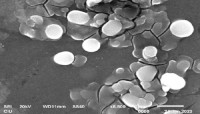Formulation of silver nanoparticles from the leaves extract of Vernonia amygdalina
https://doi.org/10.51412/psnnjp.2023.7
Keywords:
Antibacterial, antioxidant, silver nanoparticles, Vernonia amygdalinaAbstract
Background: Nanoparticles are small particles that range in size from 1 to 100 nm. Vernonia amygdalina belongs to the family of Asteraceae and it has been used traditionally to treat malaria, typhoid fever, microbial infections, diabetes mellitus, infertility and gastrointestinal disorders. The aim of this research was to synthesize silver nanoparticles (AgNPs) from the leaves extract of Vernonia
amygdalina and to evaluate the antioxidant and antibacterial effects of the nanoparticles.
Method: The silver nanoparticles were synthesized using green method and the particles were evaluated using scanning electron microscope (SEM) and X-ray diffraction (XRD). The free radical scavenging effects of the AgNPs and extract were analyzed using 2,2-diphenyl-1-picrylhydrazyl (DPPH) assays. The antibacterial effect of the leaves extract and the AgNPs were determined by disk
diffusion method on Escherichia coli and Staphylococcus aureus.
Results: SEM analysis of the formulated nanoparticles revealed a poly-dispersed spherical shaped nanoparticle with particle size of 70-90 nm. The DPPH assay revealed IC50 values of 2.80, 2.10 and 5.20 mg/mL for the leaves extract, silver nanoparticles and ascorbic acid respectively. The X-ray diffraction of the nanoparticles revealed a crystalline and polymorphic molecular structure and also confirmed that they are composed of biomolecular compounds which were responsible for the reduction of silver ions.
Conclusion: Silver nanoparticles were formulated using Vernonia amygdalina leaves extract. The formulated nanoparticles possessed significant antibacterial and antioxidant effects and also have potential pharmaceutical applications.
References
Pillai G (2014). Nanomedicine for cancer therapy: An update of FDA approved and those under various stages of development. Symbiosis
online Journal of Pharmacy and Pharmaceutical Sciences, 1(2); 1-13.
Airemwen CO, Halilu ME (2022). Formulation and invitro evaluation of polymeric metronidazole nanoparticles. Pakistan Journal of
Pharmaceutical Sciences, 35(5):1333-1338.
Kadiri O, Olawoye B (2016). Vernonia amygdalina: An Underutilized Vegetable with Nutraceutical Potentials – A Review. Turkish
Journal of Agriculture - Food Science and Technology, 4(9): 763-768.
Akpaso MI, Atangwho IJ, Akpantah A, Fischer VA, Igiri A, Ebong E (2011). Effect of Combined Leaf Extracts of Vernonia amygdalina (Bitter
Leaf) and Gongronema latifolium (Utazi) on the Pancreatic β-Cells of Streptozotocin. British Journal of Medicine and Medical Research,
(1):24-34.
Hamzah RU, Jigam AA, Makun HA, Egwin EC (2013). Antioxidant Properties of Selected African Vegetables, Fruits and Mushrooms: A
Review. Phytochemistry, 9: 203-215.
Ho WY, Liang WS, Yeap SK, Beh BK, Yousr AHN (2012). In vitro and in vivo antioxidant activity of Vernonia amygdalina water extracts, Africa
Journal of Biotechnology, 11(17): 4090–4094.
Igile GO, Oleszek W, Jurzysta M, Burda S, Fanfunso M, Fasanmade AA (1994). Flavonoids from Vernonia amygdalina and their antioxidant
activities. Journal of Agriculture and Food Chemistry, 42: 2445-2448.
KambiziL, Afolayan AJ (2001). An ethnobotanical study of plants used for the treatment of sexually transmitted disease. Journal
of Ethnopharmacology, 77: 5–9.
Huffman MA (2003). Animal self-medication and ethno-medicine exploration and exploitation of the medicinal properties of plant. Proceedings of the Nutrition Society, 62, 371 – 381 . https//doi/org/10.1079/pns2003257.
Huffman MA, Seifu M (1989). Observation on the illness and consumption of a possibly medicinal plant Vernonia amygdalina (Del.), by a wild chimpanzee in the Mahale Mountains National Park, Tanzania. Primates 30: 51 - 63. https://doi.org/10.1016/0031-9384(94)90368-9. 11. Abort AO, Raserika BH (2003). In vivo antimalarial activity of Vernonia amygdalina. British Journal of Biomedical Sciences, 60: 89-91.
Izevbigie EB, Bryant JL, Walker A(2004). Anovel natural inhibitor of extracellular signal-regulated kinases and human breast cancer cell growth, Experimental Biology and Medicine, 229: 163-169 .https://doi.org/10.1177/153537020422900205
Nwanjo HU (2005). Efficacy of aqueous leaf extract of Vernonia amygdalina on plasma lipoprotein and oxidative status in diabetic rat
model. Nigeria Journal of Physiological Sciences, 201-2:2, 30-42.
Argheore EM, Makkar HPS, Becker K (1998). Feed value of some browse plants from the central zone of Delta State Nigeria, Tropical Sciences, 38(4):97-104.
Farombi EO, Owoeye O (2011). Antioxidant and chemopreventive properties of Vernonia amygdalina and Ga r c ini a biflavonoid.
International Journal of Environmental Research and Public Health 8: 2533-2555.
Nzekekwu AK, Abosede OO (2019). Green Synthesis and Characterization of Silver Nanoparticles Using Leaves Extracts of Neem
(Azadirachta indica) and Bitter Leaf (Vernonia amygdalina), Journal of Applied Science and Environmental Management, 23 (4): 695-699.
https://dx.doi.org/10.4314/jasem.v23i4.19
Narayanaswamy K, Athimoolam R, Ayyavoo J (2015). Green synthesis of silver nanoparticles using leaf extracts of Clitoria ternatea and
Solanum nigrum and study of its antibacterial effect against common nosocomial pathogens. Journal of Nanoscience, 5(2):21-29.
Sathishkumar G, Gobinath C, Karpagam K, Hemamalini V, Premkumar K, Sivaramakrishnan S (2012). Phyto-synthesis of silver nanoscale
particles using Morinda citrifolia L. and its inhibitory activity against human pathogens. Colloids and Surfactants, 95:235-240.
Pavithra K, Sasikumar V (2015). Evaluation of free radical scavenging activity of various extracts of leaves from Kedrostis foetidissima (Jacq.)
Cogn. Food Science and Human Wellness 4 : 4 2 – 4 6 .http://dx.doi.org/10.1016/j.fshw.2015.02.001
Gulluce M, Sokmen M, Daferera D, Agar G, Ozkan H, Polissiou M and Sahin F (2003). In vitroantibacterial, antifungal and antioxidant activities of the essential oil and methanol extracts of herbal parts and callus cultures of Satureja hortensis L. Journal of Agriculture and Food Chemistry, 51(14) : 3958 - 3965. https://doi.org/10.1021/jf0340308
Arya G, Sharma N, Ahmed J, Gupta N, Kumar A, Chandra R and Nimesha S (2017). Degradation of anthropogenic pollutant and organic dyes by biosynthesized silver nano-catalyst from Cicer arietinum leaves. Journal of Photochemistry and Photobiology, B: Biology 174, 90–96.
Rakmai J, Cheirsilp B, Mejuto JC, Simal-Gandara J, Ana TG (2018). Antioxidant and antimicrobial properties of encapsulated guava leaf oil in
hydroxypropyl-betacyclodextrin. Industrial crops and products, 111: (2), 219 - 225.https://doi.org/10.1016/j.indcrop.2017.10.027
Hodek P, Trefil P and Stiborová M (2002). Flavonoids potent and versatile biologically active compounds interacting with cytochromes
P450. Chemico-biological Interactions. 139(1):1-21.
Okwu D and Omodamiro OD (2006). Effects of hexane extract and phytochemical content of Xylopia aethiopica and Ocimumgratis simumon on the uterus of guinea pig. Journal of Bioresources, 2006;8(2):114-122.

Published
How to Cite
Issue
Section
License
Copyright (c) 2023 The Nigerian Journal of Pharmacy

This work is licensed under a Creative Commons Attribution-NonCommercial 4.0 International License.


